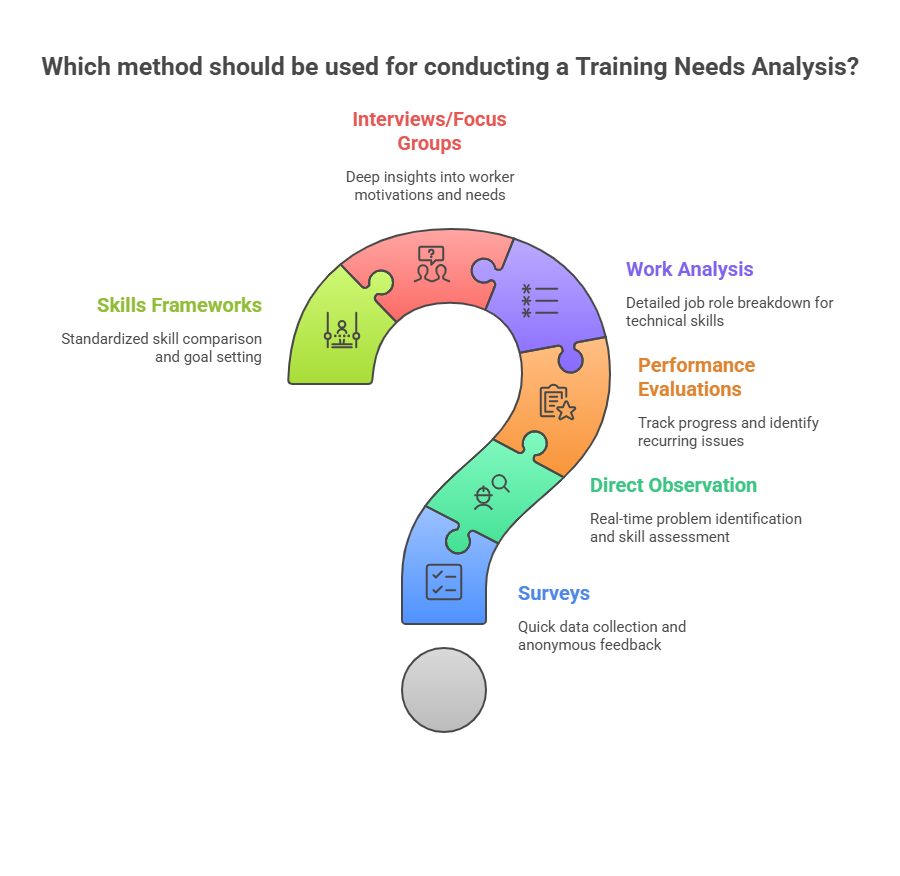Bridging Business Gaps with Training Needs Analysis
Table of Contents:
- Purpose and Importance
- Core Components
- Methods for Conducting
- Steps in Conducting
- Best Practices
- Challenges and Considerations
- FAQ
Bridging Business Gaps with Training Needs Analysis
Are your employees equipped with the skills they truly need to drive your organization forward? A Training Needs Analysis (TNA) is a structured examination of your team’s existing abilities compared to what is required for successful operation. It acts as a guiding compass, helping you target learning initiatives for maximum impact. In simple words, a TNA helps determine what kind of training is needed to improve work performance.
Purpose and Importance of Training Needs Analysis
The main reason for a TNA is to make sure that the effort put into teaching is well-directed and important. By identifying exactly what abilities are lacking and what is causing performance issues, your organization avoids broad, pointless training. It makes the most of available resources and makes learning programs have the biggest effect. A well-done TNA helps businesses to:
- Improve how employees do their jobs and how much they get done.
- Make workers happier by fixing real learning problems.
- Make training go hand in hand with the company’s goals.
- Prioritize what you spend on training based on the most important needs.
- Know if training is working by having clear ways to measure it.
Core Components of a Training Needs Analysis
A complete TNA usually has several important parts that, when put together, give a clear idea of what kind of training is needed:
- Business Goals– These are the targets that an organization wants to reach. Training supports these goals to help reach strategic targets.
- Target Audience– This is identifying which workers need training, focusing on their roles.
- Current Skill Levels– This measures the current skills that workers have to create a foundation for learning.
- Desired Skill Levels– This indicates what talents and information employees must have to be successful in their job.
- Performance Gaps– This points out differences between current skills and the needed capabilities.
- Training Methods– These are ways to learn that work well, like workshops, online learning, or training on the job.
- Evaluation Metrics– The established rules or benchmarks to measure if the training is working over time.
These parts are important to build a TNA that is planned, useful, as well as matches the things that matter most to the organization.
Methods for Conducting a Training Needs Analysis

There is no single best way to conduct a TNA. Rather, organizations often use multiple methods to collect complete information:
- Surveys, also Questionnaires– With quick data collection from workers, surveys are a fast way to focus on skills. Remaining anonymous encourages honest feedback for real opinions on training needs.
- Direct Observation– Seeing workers do their jobs shows how they use skills. It shows real-time problems or mistakes. This way is very useful when there are known guidelines for work performance.
- Performance Evaluations as well as Feedback Reviews– Looking at past reviews helps to see recurring problems training can fix. This also lets you track how workers get better after training.
- Work Analysis plus Task Examination– Taking apart job roles into small steps shows the exact talents needed for each one. This method is important for jobs that are very technical or complex.
- Interviews, also Focus Groups– Speaking with workers and managers gives deep thoughts on training needs. It reveals why workers do what they do, plus what they care about. That’s the info that surveys will not provide.
- Skills as well as Competency Frameworks– When you use set frameworks, it makes it easier to compare skills. It makes reaching the training goals standard for everyone.
Steps in Conducting a Training Needs Analysis
A typical TNA has steps that make sure everything is well-thought-out and lines up with what the company wants. The steps include:
- Define Purpose plus Objectives– Think about the reasons for doing the TNA and what should be reached. This includes connecting it to company targets. An example is making customers happier by improving how well trainers explain.
- Identify Organizational Goals– Understand business targets, which makes sure training supports them.
- Conduct Job Role, also Task Analysis– Break jobs into tasks to know what skills are needed.
- Collect Data– Gather information, such as surveys, views, talks, plus work data to find skill gaps.
- Analyze Data– Compare current skills against what is needed to learn exactly what must be taught.
- Prioritize Needs– Order the skill gaps in the order of their effect on work.
- Develop Training Objectives– Set goals that can be measured depending on what is needed.
- Design Training Solutions– Choose the right ways to train. Pick the content to use. It should fix the gaps that are most important.
- Implement Training– Give the training program to the chosen audience.
- Evaluate Effectiveness– Measure how training comes out. Compare it against goals to check its effect.
Best Practices for Effective Training Needs Analysis
TNAs that work well use these methods:
- Engage Stakeholders– Have workers, leaders, in addition to experts give their views. It makes the outcome more on target.
- Use Mixed Methods– Combine data from surveys with talks to get a full view of what is needed.
- Align with Business Strategy– Training should help the company reach its goals.
- Focus on Measurable Outcomes– Setting clear ways to measure progress helps to keep track of what happens and it makes the cost of training worth it.
- Iterate as well as Update– Training needs change over time, so TNAs should be done often.
Challenges and Considerations
While TNAs have a value, they have challenges:
- Data Accuracy– Trusting self-reporting data or personal views may lead to mistakes.
- Resource Intensity– Detailed TNAs take up time and work.
- Changing Needs– Fast changes in business may make training needs old fast.
- Stakeholder Alignment– Different goals may make it hard to agree on what training to focus on.
To fix the issues listed above, be sure to plan well, communicate openly, next to be determined to be a great leader.
FAQ : what training needs analysis
What is the definition of a Training Needs Analysis?
It’s a deep look at what training an organization requires to reach its goals.
Why do companies conduct a Training Needs Analysis?
Companies conduct these analyses to improve employee work, increase happiness, along with make sure training goes along with the company’s goals.
How often should we conduct a Training Needs Analysis?
Training Needs Analyses must be conducted regularly to keep programs modern and working in this ever-changing world.
Resources & References:
- https://www.arlo.co/blog/training-needs-analysis
- https://www.rippling.com/blog/training-needs-analysis
- https://usewhale.io/blog/training-needs-analysis-template/
- https://www.trainingfolks.com/blog/unlocking-success-corporate-training-needs-analysis-for-effectiveness
- https://www.airswift.com/blog/training-needs-analysis





